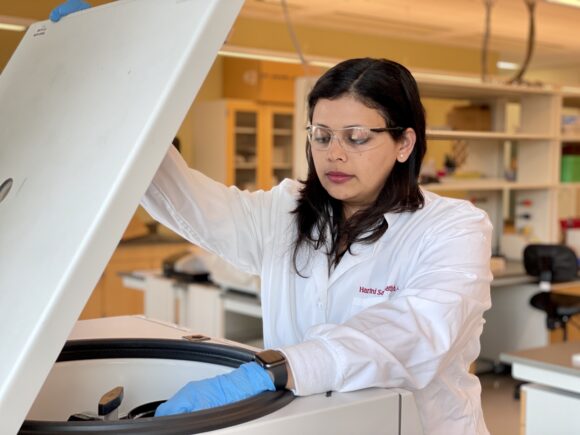
Harini Sampath in her lab in the Department of Nutritional Sciences at Rutgers School of Environmental and Biological Sciences.
Heart disease is the primary cause of death in both men and women in the United States. In fact, about 1 in 4 deaths in the U.S. is attributed to heart disease, and management of this condition costs the U.S. almost $400 billion annually. According to the Centers for Disease Control and Prevention, coronary artery disease is the most common form of heart disease and is influenced by a number of risk factors, including unhealthy diets, high blood cholesterol, type 2 diabetes, and obesity, among others.
Harini Sampath, assistant professor in the Department of Nutritional Sciences, is principal investigator (PI) of a R-01 grant valued at $1,958,160 and funded by the NIH – National Institute of Diabetes and Digestive and Kidney Diseases. The five-year project, “The role of intestinal SCD1 in regulating metabolic health,” runs through May 2026.
Sampath and her lab are focused on understanding what cellular pathways are altered during the development of obesity and related conditions such as diabetes and heart disease. “In this way, we seek to identify pathways that can be targeted for nutritional and pharmaceutical therapies to preserve health and improve health outcomes,” she said.
Many decades of research have shown that increased intake of saturated fat, the kind found in red meat and dairy, is associated with increased levels of LDL or bad cholesterol, which in turn raises the risk for heart disease. Studies in Sampath’s lab are largely focused on an enzyme, stearoyl-CoA desaturase (SCD), which modifies saturated fats in the cell.

Harini Sampath, Department of Nutritional Sciences.
“Previous studies have shown that inhibiting this enzyme can reduce body weight and confer protection against obesity and related conditions. In this project, we are focused on elucidating a role for this enzyme in the gut,” she explained.
Everything we eat is seen by our intestine or gut, which is an important regulatory and signaling organ. The gut carries out numerous functions, including sensing nutrients coming from the diet and enabling them to perform essential actions. Fats coming in from the diet are absorbed in the gut and secreted into the blood, for eventual use by other organs such as muscles and the liver. However, very high levels of fat in the blood following a meal can increase risk for heart disease and diabetes.
“Thus, understanding how the gut regulates lipid absorption and secretion into the blood is of direct relevance to studying these diseases, which impact so many individuals in both developed and developing countries,” said Sampath. “Studies in our lab have identified a role for SCD in the intestine in modulating levels of fat in the blood, particularly following a meal high in saturated fat.”
“We have also discovered that SCD in the intestine modulates the amount of energy that an organism expends, and may thus play a role in reducing weight gain on diets with varying fat levels. We are currently exploring the other effects of inhibiting this enzyme in the gut through dietary and pharmacological means,” she added.
As Sampath sees it, the potential benefits of this research are that these studies “will inform efforts to inhibit this enzyme in the gut as a possible therapeutic approach to lowering blood lipid levels and reducing the harmful consequences of dietary saturated fat intake.”
SEBS/NJAES Newsroom asked Sampath to share, in her own words, a bit about her journey to Rutgers and what inspires her as a scientist.
Why research?
“My love for basic Nutrition research was born in my undergraduate years at the University of New Hampshire, where I worked with Prof. Gale Carey to understand fat cell metabolism. My interactions with Dr. Carey led me to her alma mater, the University of Wisconsin-Madison, I obtained my doctorate in Nutritional Sciences working with Prof. James Ntambi (Department of Biochemistry, College of Agricultural and Life Sciences) on aspects of cellular lipid metabolism. Following this, I continued postdoctoral training at Oregon Health & Science University in the beautiful city of Portland, OR, working on how oxidative stress and DNA damage influence body weight regulation. All these experiences cemented my love of discovery in the basic nutritional sciences, leading ultimately to an independent faculty position at Rutgers in 2016.”
What brought you to Rutgers?
“As I started looking for places to establish my own laboratory, I was very attracted to the vibrant student and research community at Rutgers, as well as the possibility of collaborating with world-renowned scientists in the area of lipid metabolism. Therefore, I was thrilled to be recruited here, and have truly valued my interactions with colleagues and students in the Nutritional Sciences department, with fellow lipophiles at the Rutgers Center for Lipid Research (RCLR) and the New Jersey Institute for Food, Nutrition, and Health (IFNH), and beyond.”
What are your thoughts as a female in STEM sciences, especially during this month in which the focus has been on women’s history?
“Although I’m fortunate to be in a field and school like SEBS that have provided me with ample female mentors, I’m very cognizant of the fact that the STEM sciences continue to suffer from lower representation of female scientists. I have thus tried to place a special emphasis on supporting the careers of female scientists through my mentoring activities, particularly by fostering work-life balance among my research group. In general, but particularly as a woman, it’s important to remind yourself to aim high and not underestimate yourself – you too belong here.”
What inspires or motivates you?
“The thrill of discovery and of a hypothesis (finally) being right is the ultimate motivator for most scientists. As a PI, I am particularly inspired by witnessing this thrill in my trainees. When a student is able to persevere past the troubleshooting stage to get to finally taste the victory of an experiment “working out” — being able to play a role in this experience is highly rewarding. In addition, at every stage in my career, I have tried to surround myself with excellent colleagues who intellectually challenge me – these interactions have been a constant source of motivation and personal inspiration.”

